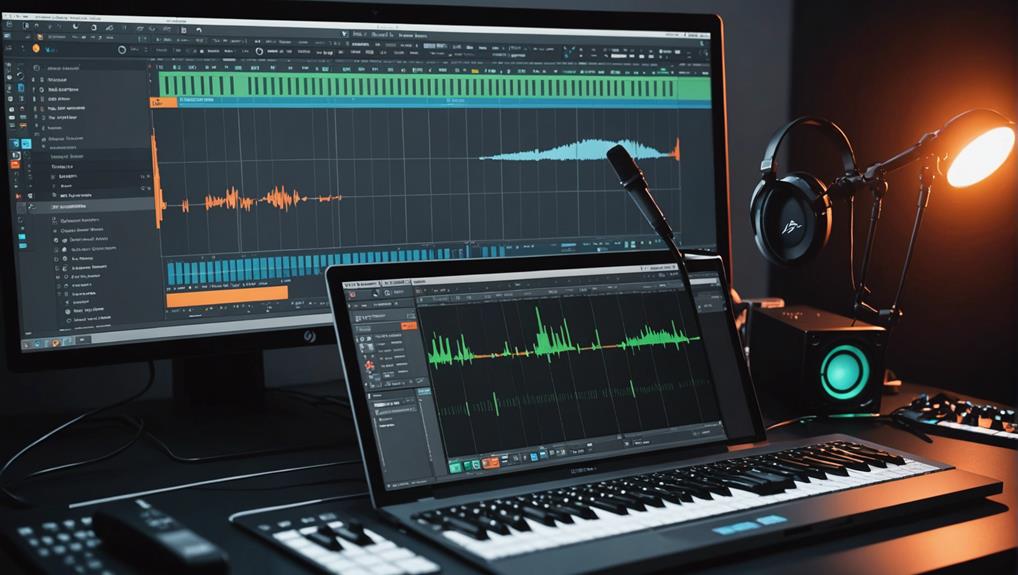To effectively mix vocals in FL Studio, start with a clean recording environment to guarantee clarity. Use equalization to eliminate muddiness and enhance the vocal’s tonal quality. Apply compression to manage dynamics and maintain consistent levels. Introduce reverb to add depth without overwhelming the mix. Balance vocals with instruments through precise EQ and sidechain compression to create space. Conduct critical listening to refine your mix and test it across various sound systems for consistency. Finally, utilize reference tracks to guide your adjustments. Dive deeper into each step for a polished, professional sound that captivates listeners.
Key Takeaways
- Start with a clean recording environment to ensure clear vocals free from background noise and unwanted echoes.
- Apply equalization techniques, including high pass filters and surgical cuts, to enhance clarity and tonal balance.
- Use compression strategically to control dynamics, maintaining consistent vocal levels throughout the track.
- Add reverb with careful adjustments to enhance depth without overwhelming the mix, focusing on intelligibility.
- Test your mix across different playback systems to ensure vocals translate well and maintain clarity on all devices.
Clean Recording Environment
The essence of a clean recording environment lies in its ability to foster clarity, allowing the true character of the vocals to shine through. A well-designed space minimizes background noise and unwanted reflections, which are critical for capturing high-quality vocal recordings.
Implementing acoustic treatment—such as sound-absorbing panels and bass traps—significantly reduces echo and reverberation, enhancing vocal clarity. Furthermore, a quiet setting free from distractions, like traffic or HVAC noises, guarantees consistent vocal performances while decreasing the need for post-processing. Additionally, applying noise reduction techniques can help further eliminate any remaining background sounds that might interfere with the recording quality.
Equalization Techniques
Although equalization may seem straightforward, mastering its techniques is essential for achieving polished vocal mixes.
Start by applying a high pass filter to eliminate unnecessary low frequencies below 100Hz, which helps prevent muddiness. Utilize a parametric EQ with bell filters to boost the fundamental frequencies, enhancing the overall tonal quality of the vocals.
For improved clarity, carefully boost vowel frequencies while dipping around 2kHz to reduce nasal tones that detract from presence. Additionally, raise higher-order harmonics above 2kHz to guarantee the vocals stand out in the mix.
Finally, implement a shelf at 20kHz for added airiness, making sure the Q value gradually decreases to unity at 10kHz for a smooth, natural shift in frequencies. Incorporating surgical EQ cuts can further refine the vocal mix by eliminating any resonant problem frequencies that may interfere with clarity.
Compression Strategies
Effective compression is an essential component in achieving a polished vocal mix, as it helps to control dynamics and ascertain vocal clarity.
Begin with a compression ratio of 5:1 for gentle vocal control, adjusting to 8:1 for aggressive peak management while preserving natural dynamics. Set the attack time between 10-30ms to allow transients to pass, with a release time of 50ms for lows, 40ms for mids, and 10ms for highs to avoid distortion.
The Fruity Limiter in FL Studio serves as an excellent stock compressor, targeting peaks while balancing quieter parts. Additionally, employing multiband compression can effectively manage low, mid, and high frequencies, particularly reducing sibilance around 7kHz. Proper threshold setting is crucial for achieving the right balance of compression and retaining vocal dynamics.
Monitor peak levels around -6 dB to -3 dB to maintain headroom and ascertain a sound professional final mix.
Adding Depth With Reverb
Adding depth to vocal tracks through reverb can greatly enhance the overall mix, creating a sense of space and dimension. In FL Studio, carefully adjusting your reverb settings is essential to achieving a polished vocal sound. Start by increasing the pre-delay to allow vocal transients to shine through, maintaining intelligibility without muddiness. Adjust the room size to suit the vocal character and overall track sound, while isolating reflections near the 8kHz frequency to preserve clarity. Utilize early reflections to enhance density, crafting an immersive experience. Finally, experiment with longer reverb tails, but be cautious to avoid overwhelming your mix. Proper use of decay time is also crucial to ensure clarity and presence in the vocals.
| Reverb Setting | Description | Purpose |
|---|---|---|
| Pre-Delay | Delays the onset of reverb | Enhances intelligibility |
| Room Size | Adjusts the simulated space | Complements vocal character |
| Frequency Isolation | Targets sibilance reflections | Maintains clarity |
| Early Reflections | Adds density to the vocal sound | Creates richness |
| Reverb Tail Length | Determines duration of reverb effect | Adds depth without muddiness |
Enhancing Clarity With Delay
How can delay be utilized to enhance vocal clarity while maintaining a rich texture? By employing quick delay settings under 10ms, you can thicken the vocal sound without introducing noticeable echoes.
It’s vital to maintain moderate feedback levels to enrich texture while preserving clarity. Isolating delay reflections to frequencies below 5kHz guarantees that the primary vocal remains prominent and free from muddiness.
Additionally, introducing subtle modulation to the delay can add complexity and depth, enhancing the overall vocal experience. This process can be further improved by utilizing a spectrum analyzer to monitor frequency distribution and ensure that vocal clarity is maintained throughout the mix.
Finally, adjusting the wet output level is necessary; reducing it allows the delayed signal to blend seamlessly with the original vocal, preserving intelligibility.
This careful balance ultimately results in a more polished and engaging vocal mix.
Balancing Vocals With Instruments
Balancing vocals with instruments requires precise frequency separation and dynamic range management to achieve a polished mix.
By employing EQ techniques to carve out dedicated spaces in the 300Hz to 3kHz range, vocal clarity can be enhanced while preventing clashes with other elements.
Additionally, carefully applying compression across both vocals and instruments guarantees consistent levels, allowing each component to coexist harmoniously within the mix. Utilizing sidechain compression effectively can further enhance clarity by dynamically adjusting instrument levels during vocal passages.
Frequency Separation Techniques
As vocals often occupy a prominent space in a mix, effective frequency separation techniques are essential to guarantee they coexist harmoniously with instrumental elements.
Utilizing stock FL Studio tools, you can achieve a clean blend by implementing the following strategies:
- Low-End Roll-Off: Use a parametric EQ to eliminate unnecessary frequencies below 100Hz in vocals, reducing muddiness and allowing instruments to fill that space.
- Problematic Frequencies: Identify and reduce frequencies between 150Hz and 300Hz to enhance clarity and prevent clashes with other tracks.
- Boost Presence: Raise mid to high frequencies around 5kHz to 10kHz to help vocals sit prominently against instrumental elements, ensuring they are both clear and engaging in the mix.
Dynamic Range Management
Achieving sonic coherence in a mix hinges on the meticulous management of dynamic range, particularly when it comes to vocals. Effective dynamic range management involves employing compression to control vocal peaks, guaranteeing they remain consistent without overshadowing other instruments.
Gentle compression settings with a ratio of 3:1 to 5:1 can help maintain a transparent sound while preserving vocal dynamics. Integrating multiband compression allows for targeted control; compressing low and mid frequencies while addressing sibilance around 7kHz ensures clarity.
Additionally, automating volume levels for specific phrases enhances clarity and presence during dynamic sections. Regularly referencing commercial tracks can provide a benchmark, guaranteeing that your vocals sit harmoniously within the overall mix, resulting in a polished and professional sound.
Final Mix Review
Conducting a thorough final mix review is essential for guaranteeing that your vocal tracks achieve their full potential within the overall composition. This process involves critical listening to identify discrepancies and refine your mix according to professional standards.
Focus on:
- Listening Across Systems: Test the mix on various sound systems to uncover any imbalances not evident on your primary monitors.
- Reference Tracks: Compare your mix’s clarity and tonal qualities against established tracks in your genre.
- Final Adjustments: Fine-tune EQ and compression settings to guarantee vocals sit well, maintaining depth while providing sufficient headroom around -6 dB to -3 dB. Additionally, consider testing mixes on diverse playback devices to ensure consistent sound across all systems.
Frequently Asked Questions
What Are the Steps to Mixing Vocals?
To effectively mix vocals, utilize vocal layering techniques, apply appropriate compression settings explained through ratios, explore reverb types comparison, and implement pitch correction tips alongside vocal automation strategies for polished, professional-sounding vocal harmonies and effects choices.
Is FL Good for Mixing Vocals?
FL Studio excels in vocal mixing due to its extensive vocal processing tools, intuitive DAW features, and versatile mixing workflow. Its user experience fosters creativity, making it a competitive choice in software comparisons for effective sound design.
How to Eq Vocals Like a Pro?
To EQ vocals like a pro, prioritize vocal frequency clarity using dynamic range techniques. Employ audio plugins judiciously, avoiding common mixing mistakes, while incorporating vocal effects and stereo imaging for depth and resonance in your recordings.
What Not to Do When Mixing Vocals?
When mixing vocals, avoid vocal distortion issues by preventing excessive reverb, ignoring dynamics, and making poor panning choices. Neglecting layering, skipping automation, and succumbing to over-compression pitfalls or improper mic placement can severely compromise quality.
Conclusion
In conclusion, the effective mixing of vocals in FL Studio necessitates a systematic approach encompassing a clean recording environment, precise equalization, strategic compression, and the thoughtful application of reverb and delay. Additionally, achieving a harmonious balance between vocals and instruments is essential for a polished final product. A meticulous review of the mix guarantees that all elements coexist cohesively, ultimately enhancing the overall sonic quality of the composition and delivering a professional auditory experience.



